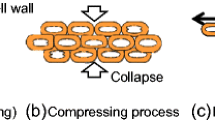Abstract
The thermoplastic flow behavior of cedar flour steamed at different temperatures in the range of 160–220°C was measured using a rheometer and compared with that of beech flour. The temperature at which the cedar flour starts to flow was approximately 70°C higher than that of beech flour, and the cedar flour exhibited low flowability. Furthermore, thermoplastic moldings were prepared from cedar and beech flours, and their physical properties were examined. Similar to the case of beech, a resin-like molding with a density of approximately 1.45 g/cm3 was obtained from the cedar flour steamed at 180°C or higher, and it was revealed by SEM observation that in these moldings wood flour particles adhere to each other. The specific bending strength was maximum for the moldings obtained from 180°C-steamed flour for both types of wood.









Similar content being viewed by others
References
Bender F, Heaney DP, Bowden A (1970) Potential of steamed wood as a feed for ruminants. Forest Prod J 20:36–41
Hayashi N, Shimizu K, Hosoya S (1989) Pretreatment of ozon for increasing the enzymatic susceptibility of autohydrolyzed softwoods. Mokuzai Gakkaishi 35:521–529
JIS A 5905 (2003) Fiberbords. Japanese Standard Association, Tokyo
JIS K 7171 (2008) Plastics—Determination of flexural properties. Japanese Standard Association, Tokyo
Lu Y, Yang B, Gregg D, Saddler JN, Mansfield SD (2002) Cellulase adsorption and an evaluation of enzyme recycle during hydrolysis of steam-exploded softwood residues. Appl Biochem Biotechnol 98–100:641–654
Maekawa E (1996) On an available pretreatment for the enzxymatic saccharification of lignocellulosic materials. Wood Sci Technol 30:133–139
Shimizu K, Sudo K, Nagasawa S, Ishihara M (1983) Enzymatic hydrolysis of woods. VII. Enzymatic susceptibility of autohydrolyzed woods. Mokuzai Gakkaishi 29:428–437
Suzuki S, Saito F (1987) Effects of environmental factors on the properties of particleboard I. Effect of temperature on bending properties. Mokuzai Gakkaishi 33:298–303
Takahashi I, Sugimoto T, Takasu Y, Yamasaki M, Sasaki Y, Kikata Y (2010a) Preparation of thermoplastic molding from steamed Japanese beech flour. Holzforschung 64:229–234
Takahashi I, Takasu Y, Sugimoto T, Kikata Y, Sasaki Y (2010b) Thermoplastic flow behavior of steamed wood flour under heat and compression. Wood Sci Technol 44(4):607–619
Tanahashi M (1990) Characterization and degradation mechanisms of wood components by steam explosion and utilization of exploded wood. Wood Res 77:49–117
Wayman M, Chua MGS (1979) Characterization of autohydrolysis aspen (P. tremuloides) lignins. Part 4. Residual autohydrolysis lignin. Can J Chem 57:2612–2616
Author information
Authors and Affiliations
Corresponding author
Rights and permissions
About this article
Cite this article
Takahashi, I., Sugimoto, T., Takasu, Y. et al. Effect of wood species on thermal flow behavior and physical properties of thermoplastic moldings. Wood Sci Technol 46, 419–429 (2012). https://doi.org/10.1007/s00226-011-0415-1
Received:
Published:
Issue Date:
DOI: https://doi.org/10.1007/s00226-011-0415-1




